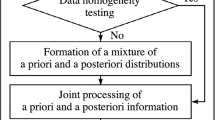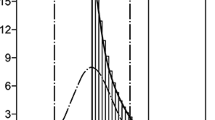Abstract
This paper considers the problem of computing the combined standard uncertainty of an indirect measurement, in which the measurand is related to multiple influence quantities through a measurement model. In practice, there may be prior information or current information, or both, about the influence quantities. We propose a practical two-step procedure for taking into account all available information (prior and current) about influence quantities in measurement uncertainty analysis. The first step is to combine prior and current information to form the merged information for each influence quantity based on the weighted average method or the law of combination of distributions. The second step deals with the propagation of the merged information to calculate the combined standard uncertainty using the law of propagation of uncertainty or the principle of propagation of distributions. The proposed two-step procedure is based entirely on frequentist statistics. A case study on the calibration of a test weight (mass calibration) is presented to demonstrate the effectiveness of the proposed two-step procedure and compare it with a subjective Bayesian approach.
Similar content being viewed by others
References
Cheney W, Kincaid D (1980) Numerical mathematics and computing. Brooks/Cole Publishing Company, Monterey, CA
D’Agostini G (1998) Jeffreys priors versus experienced physicist priors: arguments against objective Bayesian theory. In: Proceedings of the 6th Valencia international meeting on Bayesian statistics. Alcossebre, Spain, May 30th–June 4th
Demeyer S, Fischer N, Elster C (2021) Guidance on Bayesian uncertainty evaluation for a class of GUM measurement models. Metrologia 58:014001
EA Laboratory Committee and others (2013) Expression of the uncertainty of measurement in calibration. European co-operation for accreditation, Paris, France, Report No. EA-4/02 M
García-Pérez MA (2019) Bayesian estimation with informative priors is indistinguishable from data falsification. Span J Psychol. https://doi.org/10.1017/sjp.2019.41
Huang H (2014) Uncertainty-based measurement quality control. Accred Qual Assur 19:65–73
Huang H (2019) A unified formula for uncertainty estimation in interlaboratory studies and key comparisons. Cal Lab the Int J Metrol 26:22–29
Huang H (2019) Signal content index (SCI): a measure of the effectiveness of measurements and an alternative to p-value for comparing two means. Meas Sci Technol 31:045008. https://doi.org/10.1088/1361-6501/ab46fd
Huang H (2019) Why the scaled and shifted t-distribution should not be used in the Monte Carlo method for estimating measurement uncertainty? Measurement 136:282–288. https://doi.org/10.1016/j.measurement.2018.12.089
Huang H (2020) Comparison of three approaches for computing measurement uncertainties. Measurement. https://doi.org/10.1016/j.measurement.2020.107923
Huang H (2020) Two simple and practical methods for combining prior information with current measurement in uncertainty analysis. Cal Lab the Inte J Metrol 27:22–32
Huang H, Fergen RE (1995) Probability-domain simulation - a new probabilistic method for water quality modeling. WEF specialty conference toxic substances in water environments: assessment and control. Cincinnati, Ohio, pp 14–17
Jaynes ET (1988) The relation of Bayesian and maximum entropy methods. Maximum-entropy and Bayesian methods in science and engineering, vol 1. Kluwer Academic Publishers, Netherlands, pp 25–29
Joint Committee for Guides in Metrology (JCGM) (2008) Evaluation of measurement data - guide to the expression of uncertainty in measurement (GUM 1995 with minor corrections). Sevres, France
Joint Committee for Guides in Metrology (JCGM) (2008) JCGM 101: supplement 1 to the guide to the expression of uncertainty in measurement—propagation of distributions using a Monte Carlo method. Sevres, France
Kacker RN, Jones AT (2003) On use of Bayesian statistics to make the guide to the expression of uncertainty in measurement consistent. Metrologia 40:235–248
Koepke A, Lafarge T, Possolo A, Toman B (2017) Consensus building for interlaboratory studies, key comparisons, and meta-analysis. Metrologia 54:S34–S62
Phillips SD, Estler WT, Levenson MS, Eberhardt KR (1998) Calculation of measurement uncertainty using prior information. J Res Natl Inst Stand Technol 103:625–632
Possolo A, Bodnar O (2018) Approximate Bayesian evaluations of measurement uncertainty. Metrologia 55:147–157. https://doi.org/10.1088/1681-7575/aaa5be
Roesslein M, Wolf M, Wampfler B, Wegscheider W (2007) A forgotten fact about the standard deviation. Accred Qual Assur 12:495–496
Rossi GB (2014) Measurement and probability. A probabilistic theory of measurement with applications. Springer, Netherlands
Sidik K, Jonkman JN (2002) A simple confidence interval for meta-analysis. Stat Med 21:3153–3159. https://doi.org/10.1002/sim.1262
Stoudt S, Pintar A, Possolo A (2021) Uncertainty evaluations from small datasets. Metrologia 58:015014
Van der Veen AMH (2018) Bayesian methods for type a evaluation of standard uncertainty. Metrologia 55:670–684. https://doi.org/10.1088/1681-7575/aad103
Wadsworth HM Jr (1989) Summarization and interpretation of data. In: Wadsworth HM Jr (ed) Handbook of statistical methods for engineers and scientists. McGraw-Hill, Newyork, pp 21–221
White DR (2016) In pursuit of a fit-for-purpose uncertainty guide. Metrologia 53:S107–S124
Wubbeler G, Elster C (2020) On the transferability of the GUM-S1 type a uncertainty. Metrologia. https://doi.org/10.1088/1681-7575/ab50d6
Wubbeler G, Marschall M, Elster C (2020) A simple method for Bayesian uncertainty evaluation in linear models. Metrologia. https://doi.org/10.1088/1681-7575/aba3b8
Author information
Authors and Affiliations
Contributions
HH wrote the manuscript text and reviewed the manuscript.
Corresponding author
Ethics declarations
Conflict of interest
The authors declare no competing interests.
Additional information
Publisher's Note
Springer Nature remains neutral with regard to jurisdictional claims in published maps and institutional affiliations.
Appendix: The law of combination of distributions (LCD)
Appendix: The law of combination of distributions (LCD)
Consider independent and continuous random variables Xj (j = 1, 2, 3,…N) with probability density function (PDF) \({p}_{j}\left({x}_{j}\right)\) having the same support on the real line, i.e. \({x}_{j}\in (-\infty , +\infty )\). According to the product rule for independent random variables, the joint distribution of Xj, i.e. the multivariate distribution of \(\left({x}_{1}, {x}_{2}, {x}_{3}, \dots {x}_{N}\right)\), is written as
We are interested in a single-variate distribution of X, the same outcome drawn from the multivariate distribution, i.e. \({x=x}_{1}= {x}_{2}{= {x}_{3}\dots =x}_{N}\). Let \({p}_{{\text{c}}}\left(x\right)\) denote the PDF of X. \({p}_{{\text{c}}}\left(x\right)\) can be written as [11]
where \(\int \prod_{j=1}^{N}{p}_{j}\left(x\right)dx\) is the scale factor that ensures the integration of \({p}_{{\text{c}}}\left(x\right)\) to be one.
A similar formula to Eq. (21) was given in [21] (p.230) without the scaling factor. Equation (21) is referred to as the law of combination of distributions (LCD). A demonstartion of the LCD can be found in [11]. The LCD provides a mechanism to combine information (represented by PDFs) from multiple sources.
Rights and permissions
Springer Nature or its licensor (e.g. a society or other partner) holds exclusive rights to this article under a publishing agreement with the author(s) or other rightsholder(s); author self-archiving of the accepted manuscript version of this article is solely governed by the terms of such publishing agreement and applicable law.
About this article
Cite this article
Huang, H. A practical two-step procedure for taking into account all available information (prior and current) about influence quantities in measurement uncertainty analysis. Accred Qual Assur (2024). https://doi.org/10.1007/s00769-024-01583-0
Received:
Accepted:
Published:
DOI: https://doi.org/10.1007/s00769-024-01583-0




